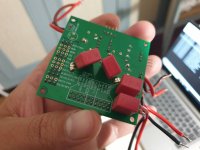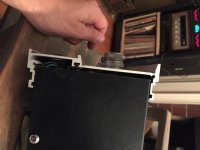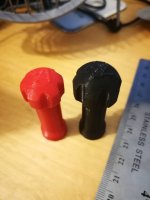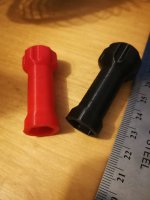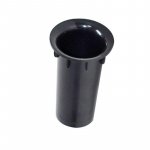I have always received generous and helpful responses to my posts on DIY Audio, so this post is my effort to contribute something that might be of value to some members.
I suspect that I may be like some of you in that I buy a speaker driver about which I have read good things but don't build with it for some time due to the daily demands of the life I lead. I have collected four full range drivers in this manner, and, having decided to finalize my plans for each one and actually BUILD some speakers, I chose to do a listening comparison test to enable me to choose the best use for each one. Please note that the review which follows is based upon my own listening preferences and hearing (I can no longer hear anything above the low teens kHz in frequency). I enjoy a wide variety of music and have attended many live concerts (mostly of classical music, including orchestral, choral, and chamber music, as well as jazz), so I know how music, voices, and instruments sound in various live settings. I have heard many different audio reproduction systems, and over the years I formed a preference for a sound which I describe as warm, yet clear. I am very sensitive to upper midrange frequencies, and I tend to dislike any component or system which produces a sound which is hot in the upper midrange. Please note also that I do not say that my preferences should be your preferences, nor that my impressions should be yours as well.
I obtained a piece of 4' by 4' (122cm by 122cm) plywood which is 1/2" (13mm) thick. I surface mounted one each of my four full range drivers in a square arrangement close to the center of the baffle with the center of each driver equidistant from the baffle center. I did not chamfer the back perimeters of the mounting holes and did not attach any stiffening braces to the baffle. The baffle rested upon the floor at an angle that put the center of the baffle on axis with my eyes as I sat in a chair at one meter distant from that center. It is possible, perhaps even probable, that this arrangement produced sympathetic resonances from both the baffle and the other drivers, and though this was not a scientifically controlled test, I believe I can claim that the drivers were tested under identical conditions.
I have a stereo receiver with four speaker outputs in an A/B/A+B arrangement. I connected each speaker output to a different driver and used the speaker selection switch together with the balance control on the receiver to isolate the audio output first to one speaker, then to another, in a more or less random manner, always knowing to which driver I was sending the audio. After forming impressions of each one, I then switched the audio in a purposely directed manner to compare each speaker to each other. After listening to each speaker at an equal level setting on the receiver, I then tried each one at an increased level and subsequently with a bass boost from the tone control on the receiver. I listened to each speaker both on axis and off axis at an angle I believe to have been about 15 degrees. One of the drivers produces an SPL significantly higher than the other 3 (about 3dB). I tried to adjust the volume downward as I listened to this driver in an effort to equalize the level to the other drivers, but as I formed my impressions I believed that I could successfully compensate for this difference and simply left the volume level the same for all the drivers. The music I used for the test was a mono recording of "Sgt. Pepper's Lonely Hearts Club Band" by the Beatles. I chose this for a variety of reasons. It is a recording to which I have listened for years on a variety of sound systems and with which I am very familiar. It has a large number of musical sounds and effects, with vocals, guitars, drums, pianos, electric organs, harps, clarinets, string ensembles, full orchestras, and even animal and crowd sounds, so it provides a good sampling of the variety of audio which a speaker driver might be used to reproduce. It is a famous recording which many people will have heard. Finally, it is a mono recording, so each speaker would receive the same signal as I switched between them. I played the recording all the way through twice and tried to give equal time listening to each speaker.
The four drivers I tested are listed below with the factory T/S numbers I believe are relevant to this test. I have tested each driver with the DAT system, but I list the factory numbers to avoid any confusion or disagreement engendered by home testing. I did not try to perform any electronic frequency response analysis. I simply listened.
Tang Band W8-1808---SPL 93dB, Sd 220 sq. cm, Xmax 5mm, Fs 45Hz
Tang Band W5-1611SAF---SPL 90 dB, Sd 94 sq. cm, Xmax 3mm, Fs 60Hz
Markaudio Alpair 10P---SPL 90dB, Sd 88 sq. cm, Xmax 7mm, Fs 42 Hz
Tang Band W5-2143---SPL 90 dB, Sd 94 sq. cm, Xmax 2.5mm, Fs 55Hz
The drivers are listed in the chronological order in which they were purchased.
Tang Band W8-1808 (paper cone, whizzer, phase plug)
It was immediately apparent that this driver has a frequency response which rises toward the upper midrange and treble. I listened to it on axis for this test, but if I were using it regularly for recreational listening I could not listen to it on axis with any music which has much high frequency information. Off axis by 15 degrees it improves considerably and produces a sound that is smooth, detailed, and a pleasure to hear. Given the fact that it is a larger driver than the other 3 it is no surprise that it produces more bass response (with the bass boost on the receiver, quite a bit more). The character of the sound is very much the same at low and high listening levels. It was interesting to discover that the rising response on axis was not objectionable on songs that did not have much high frequency content, such as "She's Leaving Home" and "When I'm Sixty-Four". The sound on axis was very good on those.
Tang Band W5-1611SAF (polypropylene cone, phase plug)
This driver sounds somewhat dull compared to the other three. Both on and off axis the highs are not as pronounced. Other than that, it produces a nice sound that is not objectionable in any way. It is one of the two drivers that produced the least bass response. The sound really improved with the higher listening level, with the highs becoming clearer and the sound being better balanced all round. I don't know how to account for this other than that it may have been an effect of the Fletcher-Munson curve. I think it is a nice driver, but the other three produce better detail on a variety of sounds.
Markaudio Alpair 10P (glass fiber and paper cone, shallow profile)
This is a very versatile speaker. It sounds good on a variety of material and produces a wealth of detail. It's sound on axis is detailed, clear, and comfortable, with no upper midrange screeching, and the off-axis sound is essentially the same. With the bass boost it produced a bass response second only to the W8-1808. Compared to the other three, it has a slight coloration that I can only describe as an "Aw" sound, as though someone were speaking through cupped hands. I suspect some lower midrange resonance is responsible for that coloration. The sound at the lower level was clearer than the sound at the higher level, which by comparison had a "congested" quality, sounding like too much emphasis in the broad midrange. I thought of this driver as the best full range speaker I had heard until I bought the next one on the list.
Tang Band W5-2143 (bamboo fiber and paper cone, phase plug)
This was the most recent full range driver about which I read and with which I was intrigued, so I decided to give it a try. I'm glad I did, because this one takes the crown as the best full range speaker I have heard. Compared to the other three, the impression I received as I listened was similar to that of a good pair of headphones. Smooth yet detailed, with no part of the audio spectrum objectionably pronounced, clear and warm but not bloated or congested, it sounds the best on the widest variety of material. Though the bass response with the bass boost was probably the least of all four, the tonal balance on axis was the best, and it sounds essentially the same off axis also. And, though it may seem to be a logical incongruity, the sound at the higher level was the same, only better. I really like this speaker.
I think each of these drivers produce good sound, and I think I could be content with any one of them if I were limited to using only one. Each has its individual strengths and weaknesses, and I hope to use each one in a way that will maximize its strengths while minimizing its weaknesses. These are my decisions regarding these drivers:
Though the W8-1808 is the only one I would consider using as a true solo full range driver (in a bass reflex cabinet), it will see duty in a sealed box FAST construction with a bass driver providing the low end. I will listen to it mainly off axis.
The W5-1611SAF I will use mounted in a bass reflex box as a utility speaker for the garage or an ambient speaker elsewhere.
The Alpair 10P will be used in an open baffle FAST construction with woofers on the same open baffle.
The W5-2143 will be used in yet another FAST construction which will be meant for close field (one meter or less) listening.
Please keep in mind that I am a music lover and not a speaker builder by profession or long experience. The number of speaker drivers I have heard and evaluated is not that of many members on this forum, so I offer my opinions with that qualifier. These opinions are valid for my preferences, and, I repeat, I don't expect anyone to agree with my opinions or share my preferences.
